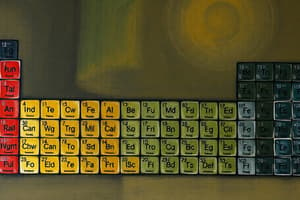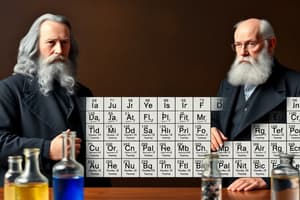Podcast
Questions and Answers
How did Mendeleev organize the elements in his periodic table?
How did Mendeleev organize the elements in his periodic table?
Arranged the elements into rows in order of increasing mass so that elements with similar properties were in the same column.
What is a periodic table?
What is a periodic table?
An arrangement of elements in columns, based on a set of properties that repeat from row to row.
How did Dmitri Mendeleev develop an approach for organizing the elements?
How did Dmitri Mendeleev develop an approach for organizing the elements?
Solitaire
What was Mendeleev's prediction?
What was Mendeleev's prediction?
What evidence helped verify the usefulness of Mendeleev's table?
What evidence helped verify the usefulness of Mendeleev's table?
What name did Mendeleev give the missing element one space below Aluminum?
What name did Mendeleev give the missing element one space below Aluminum?
What was the name of the element discovered in 1875 by a French chemist?
What was the name of the element discovered in 1875 by a French chemist?
What are some uses for the element gallium?
What are some uses for the element gallium?
In Mendeleev's periodic table, elements with similar properties were grouped?
In Mendeleev's periodic table, elements with similar properties were grouped?
How is the modern periodic table organized?
How is the modern periodic table organized?
What is each row on the Periodic Table called?
What is each row on the Periodic Table called?
How many periods are there on the Periodic Table?
How many periods are there on the Periodic Table?
What is each column on the Periodic Table called?
What is each column on the Periodic Table called?
What is periodic law?
What is periodic law?
What does the atomic mass of an element depend on?
What does the atomic mass of an element depend on?
What is an atomic mass unit?
What is an atomic mass unit?
What are the four pieces of information for each element?
What are the four pieces of information for each element?
What categories are used to classify elements on the periodic table?
What categories are used to classify elements on the periodic table?
Where are the Transition Metals on the Periodic Table?
Where are the Transition Metals on the Periodic Table?
What are Transition Metals?
What are Transition Metals?
What is a nonmetal?
What is a nonmetal?
What are the characteristics of a nonmetal?
What are the characteristics of a nonmetal?
What is a metal?
What is a metal?
What are the characteristics of a metal?
What are the characteristics of a metal?
What is the most reactive nonmetal?
What is the most reactive nonmetal?
What is a metalloid?
What is a metalloid?
How do properties vary across a period in the periodic table?
How do properties vary across a period in the periodic table?
Why do the elements in a group have similar properties?
Why do the elements in a group have similar properties?
What is a valence electron?
What is a valence electron?
Why is hydrogen grouped with the metals in Group 1A?
Why is hydrogen grouped with the metals in Group 1A?
What are the elements in Group 1A called?
What are the elements in Group 1A called?
How does the reactivity of the Alkali Metals respond as you go down the group?
How does the reactivity of the Alkali Metals respond as you go down the group?
What are the elements in Group 2A called?
What are the elements in Group 2A called?
How many valence electrons do Group 2A elements have?
How many valence electrons do Group 2A elements have?
Flashcards are hidden until you start studying
Study Notes
Dmitri Mendeleev and the Periodic Table
- Mendeleev arranged elements in rows by increasing atomic mass, grouping similar properties in columns.
- Developed his table by playing a game of solitaire, leading to an organized method for categorizing elements.
Predictions and Verification
- Mendeleev predicted properties of undiscovered elements based on existing elements near blank spaces in his table.
- The accuracy of his predictions and close matches with actual discovered elements confirmed the utility of his periodic table.
Missing Element
- Mendeleev referred to the unknown element below Aluminum as eka-aluminum, later discovered as gallium in 1875.
Gallium
- Gallium is utilized in traffic signals and small light-emitting diodes (LEDs).
Structure of the Modern Periodic Table
- The modern periodic table is organized by increasing atomic number (number of protons) rather than mass.
- Rows are termed periods, with a total of 7 periods and columns referred to as groups.
Periodic Law
- Periodic law states that physical and chemical properties of elements recur in a predictable manner with increasing atomic number.
Atomic Mass
- Atomic mass is influenced by the natural distribution of an element's isotopes and their individual masses.
- The atomic mass unit is defined as one twelfth the mass of a carbon-12 atom.
Element Information
- Each element is described by four pieces of information: atomic mass, atomic number, element symbol, and element name.
Classification of Elements
- Elements are categorized as metals, nonmetals, and metalloids.
- Transition metals span groups 3 through 12, acting as a bridge between left and right elements.
Properties of Metals and Nonmetals
- Metals: Good conductors of electricity and heat, malleable, ductile, and high boiling points.
- Nonmetals: Brittle, poor conductors, low boiling points, and the most reactive nonmetal is fluorine.
Metalloids
- Metalloids possess properties between metals and nonmetals.
Trends Across the Periodic Table
- As one moves left to right across a period, elements trend from metallic properties to nonmetallic properties.
- Elements in the same group share similar properties due to identical valence electron counts.
Valence Electrons
- Valence electrons are located in the highest occupied energy level of an atom and determine chemical reactivity.
- Hydrogen, having one valence electron, is placed with alkali metals in Group 1A.
Alkali and Alkaline Earth Metals
- Group 1A elements are called alkali metals; their reactivity increases down the group.
- Group 2A elements are known as alkaline earth metals and contain two valence electrons.
Studying That Suits You
Use AI to generate personalized quizzes and flashcards to suit your learning preferences.




